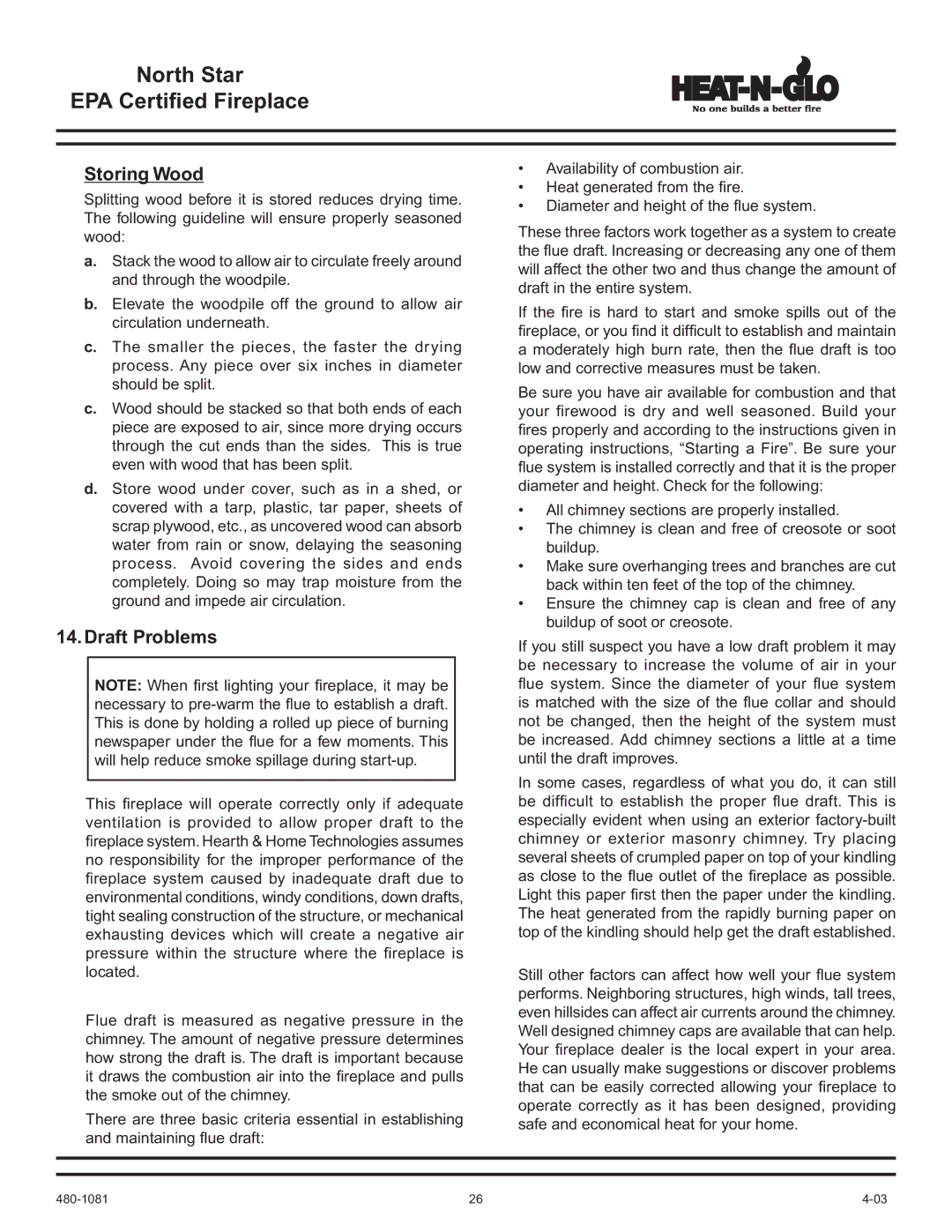
North Star
EPA Certified Fireplace
Storing Wood
Splitting wood before it is stored reduces drying time. The following guideline will ensure properly seasoned wood:
a.Stack the wood to allow air to circulate freely around and through the woodpile.
b.Elevate the woodpile off the ground to allow air circulation underneath.
c.The smaller the pieces, the faster the drying process. Any piece over six inches in diameter should be split.
c.Wood should be stacked so that both ends of each piece are exposed to air, since more drying occurs through the cut ends than the sides. This is true even with wood that has been split.
d.Store wood under cover, such as in a shed, or covered with a tarp, plastic, tar paper, sheets of scrap plywood, etc., as uncovered wood can absorb water from rain or snow, delaying the seasoning process. Avoid covering the sides and ends completely. Doing so may trap moisture from the ground and impede air circulation.
14.Draft Problems
NOTE: When first lighting your fireplace, it may be necessary to
This fireplace will operate correctly only if adequate ventilation is provided to allow proper draft to the fireplace system. Hearth & Home Technologies assumes no responsibility for the improper performance of the fireplace system caused by inadequate draft due to environmental conditions, windy conditions, down drafts, tight sealing construction of the structure, or mechanical exhausting devices which will create a negative air pressure within the structure where the fireplace is located.
Flue draft is measured as negative pressure in the chimney. The amount of negative pressure determines how strong the draft is. The draft is important because it draws the combustion air into the fireplace and pulls the smoke out of the chimney.
There are three basic criteria essential in establishing and maintaining flue draft:
•Availability of combustion air.
•Heat generated from the fire.
•Diameter and height of the flue system.
These three factors work together as a system to create the flue draft. Increasing or decreasing any one of them will affect the other two and thus change the amount of draft in the entire system.
If the fire is hard to start and smoke spills out of the fireplace, or you find it difficult to establish and maintain a moderately high burn rate, then the flue draft is too low and corrective measures must be taken.
Be sure you have air available for combustion and that your firewood is dry and well seasoned. Build your fires properly and according to the instructions given in operating instructions, “Starting a Fire”. Be sure your flue system is installed correctly and that it is the proper diameter and height. Check for the following:
•All chimney sections are properly installed.
•The chimney is clean and free of creosote or soot buildup.
•Make sure overhanging trees and branches are cut back within ten feet of the top of the chimney.
•Ensure the chimney cap is clean and free of any buildup of soot or creosote.
If you still suspect you have a low draft problem it may be necessary to increase the volume of air in your flue system. Since the diameter of your flue system is matched with the size of the flue collar and should not be changed, then the height of the system must be increased. Add chimney sections a little at a time until the draft improves.
In some cases, regardless of what you do, it can still be difficult to establish the proper flue draft. This is especially evident when using an exterior
Still other factors can affect how well your flue system performs. Neighboring structures, high winds, tall trees, even hillsides can affect air currents around the chimney. Well designed chimney caps are available that can help. Your fireplace dealer is the local expert in your area. He can usually make suggestions or discover problems that can be easily corrected allowing your fireplace to operate correctly as it has been designed, providing safe and economical heat for your home.
26 |
